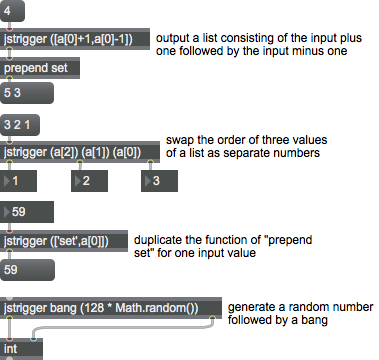jstrigger
Description
The jstrigger object is similar to the trigger object, except that typed-in arguments within parentheses are passed to the Javascript evaluator. For more information on the Max implementation of Javascript, refer to the Javascript in Max manual. For complete information about Javascript itself, consult a reference book such as Javascript: The Definitive Guide by David Flanagan, published by O'Reilly.
Examples

Arguments
sequential-Javascript-instructions [numbers, symbols, or expressions]
The arguments to the jstrigger object may be either constants or expressions. Constants are numbers or symbols. For each constant, an outlet will be created, and the constant value will be sent out the corresponding outlet when the object receives a message in its left inlet. For example, jstrigger with the arguments would send out the right outlet, followed by out the middle outlet, followed by out the left outlet.
Expressions are Javascript expressions contained within parentheses. You can include more than one Javascript statement can be contained within the parentheses, but you must separate the statements by semicolons (;). A semicolon after the last statements is not required, and the word return is not required either. To return a list, you can either create an array object or place items in square brackets separated by commas. Javascript allows you to enter expressions between the commas. See the Examples section.
For each expression, an outlet will be created, and the value of the expression will be sent out the corresponding outlet when the jstrigger object receives a message in its left inlet.
Note that any use of semicolons or commas in an object box require a preceding backslash (\) character, otherwise you will see the following error message in the Max Console and the object will not be created:
* error: object box has comma or semicolon
In addition, it is strongly recommended to use single quotes (') rather than double quotes to define string literals. The use of double quotes can produce unexpected results in jstrigger when the object is saved and recreated in a patcher.
Attributes
Common Box Attributes
annotation [symbol]
Sets the text that will be displayed in the Clue window when the user moves the mouse over the object.
background [int] (default: 0)
Adds or removes the object from the patcher's background layer. adds the object to the background layer, removes it. Objects in the background layer are shown behind all objects in the default foreground layer.
color [4 floats]
Sets the color for the object box outline.
fontface [int]
Sets the type style used by the object. The options are:
plain
bold
italic
bold italic
Possible values:
0 = 'regular'
1 = 'bold'
2 = 'italic'
3 = 'bold italic'
fontname [symbol]
Sets the object's font.
fontsize [float]
Sets the object's font size (in points).
Possible values:
'8'
'9'
'10'
'11'
'12'
'13'
'14'
'16'
'18'
'20'
'24'
'30'
'36'
'48'
'64'
'72'
hidden [int] (default: 0)
Toggles whether an object is hidden when the patcher is locked.
hint [symbol]
Sets the text that will be displayed in as a pop-up hint when the user moves the mouse over the object in a locked patcher.
ignoreclick [int] (default: 0)
Toggles whether an object ignores mouse clicks in a locked patcher.
jspainterfile [symbol]
JS Painter File
patching_rect [4 floats] (default: 0. 0. 100. 0.)
Sets the position and size of the object in the patcher window.
position [2 floats]
Sets the object's x and y position in both patching and presentation modes (if the object belongs to its patcher's presentation), leaving its size unchanged.
presentation [int] (default: 0)
Sets whether an object belongs to the patcher's presentation.
presentation_rect [4 floats] (default: 0. 0. 0. 0.)
Sets the x and y position and width and height of the object in the patcher's presentation, leaving its patching position unchanged.
rect [4 floats]
Sets the x and y position and width and height of the object in both patching and presentation modes (if the object belongs to its patcher's presentation).
size [2 floats]
Sets the object's width and height in both patching and presentation modes (if the object belongs to its patcher's presentation), leaving its position unchanged.
textcolor [4 floats]
Sets the color for the object's text in RGBA format.
textjustification [int]
Sets the justification for the object's text.
Possible values:
0 = 'left'
1 = 'center'
2 = 'right'
varname [symbol]
Sets the patcher's scripting name, which can be used to address the object by name in pattr, scripting messages to thispatcher, and the js object.
Messages
bang
int
Arguments
float
Arguments
list
Arguments
anything
Arguments
Output
anything
When the jstrigger object receives a message in its inlet, the expressions are evaluated from right to left and their results are sent out the corresponding outlets from right to left.
See Also
| Name | Description |
|---|---|
| JavaScript Usage | JavaScript Usage |
| bangbang | Output a bang from many outlets |
| js | Execute Javascript |
| jsui | Javascript user interfaces and graphics |